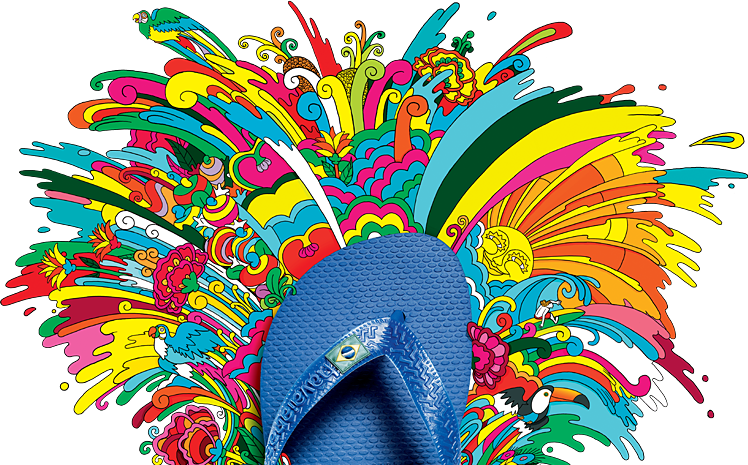
image: Havaianas
Havaianas has managed to “take over the world,” according to no shortage of media outlets and analysis, alike. In a span of 55 years, the Brazilian flip-flop brand went from a little-known sandal brand whose footwear once served as “poverty certificates” for their wearers, according to Rui Porto, a long-time director Havaianas, to a highly successful international footwear force, recently acquired in a $1.1 billion deal to three Brazilian banking groups.
Interestingly, while much has been made of Havaianas’ rise to fame, little has been made of how – legally – the company was able to turn an otherwise completely commonplace shoe into a footwear design that is protected on an international scale.
Selling more than 200 million pairs of sandals per year and maintaining a network of brick and mortar stores across the globe, Havaianas, which first hit the market in 1962, is best known for its mass-production of $18 flip-flops made from rubber. The company’s footwear, which has been described as “the simplest shoes on the planet,” consists merely of a piece of plastic, shaped roughly to the outline of your foot, and a simple strap holding the sole to your toes. Yet, despite its seemingly un-extraordinary design, Havaianas sandals have swiftly become a go-to for everyone from “minimum wage earners behind juice bar counters to newly minted millionaires,” according to the Associated Press.
Not All That Original
It is hardly a secret that Havaianas’ famed sandals were not borne from a wildly novel concept. In fact, they were closely inspired by the traditional Japanese sandal known as Zori, which had rice straw soles and fabric straps. Instead of straw, however, Havaianas sandal soles were made out of rubber, but the rice grain inspired the texture of the rubber sole.
So, while the brand certainly did not achieve its success on the back of valuable patents protecting a novel design or form of manufacturing, Havaianas has largely made its way thanks to another intellectual property-related strength: Branding and the trademark rights that come along with it, which have helped the brand to hold its own against cheap versions of what is an easy-to-replicate design.”
But first, Havaianas had to become coveted enough to merit copying. Prior to 2000, Havaianas’ footwear were exported from Brazil to neighboring countries like Bolivia and Paraguay alone. In 2000, in furtherance of a big push to go global, the brand began exporting to “Portugal and Australia, and then to Japan, the country that inspired the original product. Later, the sandals reached the United States and South America, such as Argentina and Uruguay, as well as other countries in Europe.”
As of now, Havaianas are stocked in over 120 countries.
In addition to expansion in terms of exports, the company also began to significantly broaden its offerings by adopting fashion-focused color combinations and prints, and staying abreast of and playing into various international trends in footwear, the brand has routinely partnered with top designers and heavily invested in targeted advertising in order to reach a larger audience and shed its humble roots.
“At the start,” Porto told HuffPost, “we focused only on mass media, like television and radio. Then we started placing advertisements in fashion and celebrity magazines and we sponsored fashion events such as São Paulo Fashion Week.”
An Arsenal of IP
Meanwhile, in the midst of building brand awareness around the world with the help of its celebrity fans (everyone from Kim K and Gwyneth Paltrow to Kylie Minogue and Madonna) and traditional ad campaigns, alike, Havaianas worked on assembling an arsenal of intellectual property protections, starting with its name.
Sao Paulo Alpargatas (“Alpargatas”) – the company that owns Havaianas, as well as Mizuno, Timberland, Dupé, Osklen and Meggashop – has built an international portfolio of trademark rights that dates back to 1962 and has been busy policing those trademarks to ensure that it is the only company making use of the name.
But in addition to – and maybe even more importantly than – raking up a stable of registrations for the Havaianas name, the brand has laid claim, legally, to its subtle but very recognizable decorative design elements, such as the pattern that adorns the its sandals’ straps. With federal registrations in the U.S. and abroad, Alpargatas has been in and out of court fighting over such decorative-but-also-sourcing identifying elements, including the “two symmetrical sequences of geometrical figures in the form of an elongated ‘Z,’ intertwined and positioned slantwise.”

One of Havaianas’ trade dress registrations
One such case came several years ago when Havaianas sued footwear wholesaler, Too Beach, for trade dress infringement in connection with lookalike sandals. Too Beach countered by arguing that Havaianas’ trademark registration was invalid.
In late 2014, the Paris Court of Appeals held that the Havaianas’ registration, which is “composed of two symmetrical sequences of geometrical figures in the form of an elongated Z,” (the designs on the sandals’ straps), is, in fact, a valid, despite the lower court’s ruling to the contrary.
In particular, the court held that the design is “readily identifiable” as a source indicator of the sandal company by a significant portion of the consuming public. As such, the court held that the trademark is both “distinctive” and valid. The court further held that the defendant, Too Beach, a French wholesaler, had infringed that mark, and ordered it to pay damages, and immediately and permanently cease sales of the infringing sandals.
Add to that European Union registration (and others) the handfuls of federally registered trademarks that Alpargatas holds in the U.S. for everything from the “Havaianas” name to the individual “Greek designs” that make up the pattern adorns the sandal straps and the larger “design pattern consisting of interlocking, raised Z shaped lines applied to the upper portion of the strap of a flip flop.”
So, there is, in fact, considerable IP behind the Havaianas success story, despite the fact that the product is about as low-tech as it gets.







